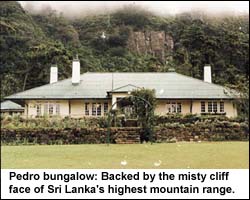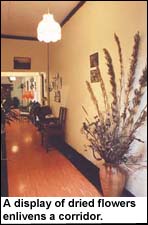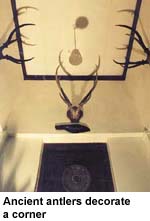
Plantation Home
 It
is no surprise that Brit- ish settlers, struggling to pronounce the name
of Sri Lanka's highest mountain, dubbed Pidurutalagalla with the Spanish-sounding
moniker, Pedro. Although there was a tea estate with that name over 100
years ago, today's bungalow is of a more recent vintage. It
is no surprise that Brit- ish settlers, struggling to pronounce the name
of Sri Lanka's highest mountain, dubbed Pidurutalagalla with the Spanish-sounding
moniker, Pedro. Although there was a tea estate with that name over 100
years ago, today's bungalow is of a more recent vintage.
That indefatigable chronicler of Ceylon and its tea industry and railways,
Henry W. Cave, wrote in Golden Tips, published in 1900, of taking
"the eastern exit from the plains of Nuwara Eliya" to find "five
miles of the best road in Ceylon winding up an easy incline to Kandapola."
He added: "On our way thither we shall pass through some estates
which, notwithstanding their great elevation are famous alike for their
yield and the high quality of their tea: Pedro after the famous mountain
where it is situated...the bushes seeming to enjoy the cool atmosphere..."
Pedro's fame for quality tea has been maintained through the century.
I wonder, though, what happened to the estate (and why its intriguing name?)
called Elephant Nook, which Ferguson's record as being part of Pedro until
it had disappeared from its pages by the 1983-85 edition.
Gone, too, is any vestige of the bungalow that was on the estate in
1900 and originally built in 1885. The present bungalow, astride a ridge
below a sheer rock face of Sri Lanka's highest mountain range has the functional
lines of the l930s. Even so, it follows a pattern familiar in bungalows
of an earlier vintage with two wings linked by a corridor running its breadth.
This is one of those bungalows that needs an interested planter, and
his wife, to give it character. Planter Roshan Rajadurai, aided by his
wife has done just that, adding touches that make the bungalow a home.
Their efforts show that it is not money that is needed to give a chilly
property warmth, but a partnership in creative spirit.
 From
the moment of entering through the broad doors from the porch the visitor
gains an impression of a bungalow that has gained dignity from its occupants.
Instead of the hallway being the untidy preserve of hats, muddy boots and
umbrellas, a display of dried flowers from Horton Plains and rough-hewn
clay pots conveys an ambience of orderly cosiness. From
the moment of entering through the broad doors from the porch the visitor
gains an impression of a bungalow that has gained dignity from its occupants.
Instead of the hallway being the untidy preserve of hats, muddy boots and
umbrellas, a display of dried flowers from Horton Plains and rough-hewn
clay pots conveys an ambience of orderly cosiness.
 A
quartet of ancient antlers is suspended above a conjunction of doors and
passages. Of the basic pieces of furniture that give a clue to the bungalow's
period, there is a fine teak desk with an additional set of drawers on
its top. This forms the focal point of the planter's office, where books
and magazines are neatly labelled. A
quartet of ancient antlers is suspended above a conjunction of doors and
passages. Of the basic pieces of furniture that give a clue to the bungalow's
period, there is a fine teak desk with an additional set of drawers on
its top. This forms the focal point of the planter's office, where books
and magazines are neatly labelled.
This room has a fireplace, as does the sitting room which adjoins it,
and there is also another one in the dining room, an easy solution to the
chill of the hill country, typical at 6,200 feet above sea level.
Bedrooms lead off one side of the central corridor, reception rooms
off the other. Dried flower arrangements enliven the monotony of the passageway.
As in traditional plantation bungalows accustomed to accommodating a Visiting
Agent on his rounds, the bedrooms at the more modern Pedro are always kept
prepared for unexpected visitors.
One of the rooms has a fine pair of beds with an art deco hint in their
head and foot boards. It shows that not all plantation furniture of value
has to be Victorian or Edwardian.
An added attraction of the room is the plant arrangement nestling in
a stand made of a dried tree.
The Pedro plantation is of interest to tea fanatics because of the continued
quality of its brand, and also of the Lover's Leap and Mahagastota brands
manufactured in its factory. The bungalow, thanks to the care of its present
occupants, may not have the character of older plantation homes, but it
has the quality to match its famous name.
|


 It
is no surprise that Brit- ish settlers, struggling to pronounce the name
of Sri Lanka's highest mountain, dubbed Pidurutalagalla with the Spanish-sounding
moniker, Pedro. Although there was a tea estate with that name over 100
years ago, today's bungalow is of a more recent vintage.
It
is no surprise that Brit- ish settlers, struggling to pronounce the name
of Sri Lanka's highest mountain, dubbed Pidurutalagalla with the Spanish-sounding
moniker, Pedro. Although there was a tea estate with that name over 100
years ago, today's bungalow is of a more recent vintage. From
the moment of entering through the broad doors from the porch the visitor
gains an impression of a bungalow that has gained dignity from its occupants.
Instead of the hallway being the untidy preserve of hats, muddy boots and
umbrellas, a display of dried flowers from Horton Plains and rough-hewn
clay pots conveys an ambience of orderly cosiness.
From
the moment of entering through the broad doors from the porch the visitor
gains an impression of a bungalow that has gained dignity from its occupants.
Instead of the hallway being the untidy preserve of hats, muddy boots and
umbrellas, a display of dried flowers from Horton Plains and rough-hewn
clay pots conveys an ambience of orderly cosiness. A
quartet of ancient antlers is suspended above a conjunction of doors and
passages. Of the basic pieces of furniture that give a clue to the bungalow's
period, there is a fine teak desk with an additional set of drawers on
its top. This forms the focal point of the planter's office, where books
and magazines are neatly labelled.
A
quartet of ancient antlers is suspended above a conjunction of doors and
passages. Of the basic pieces of furniture that give a clue to the bungalow's
period, there is a fine teak desk with an additional set of drawers on
its top. This forms the focal point of the planter's office, where books
and magazines are neatly labelled.
